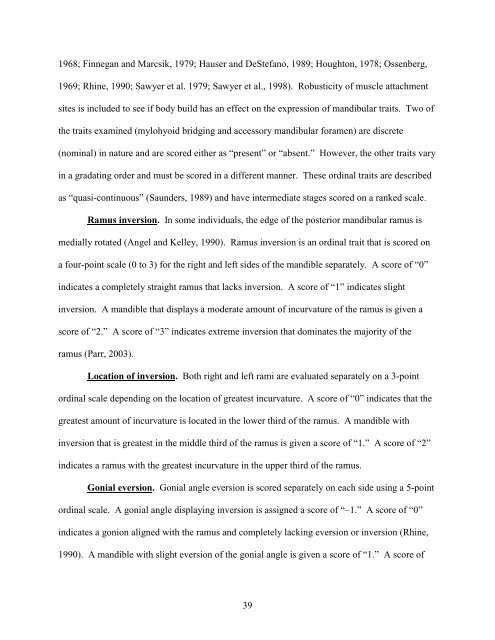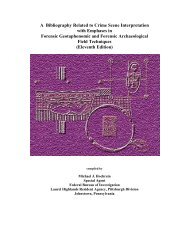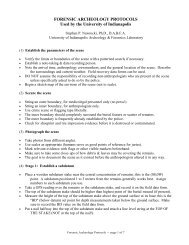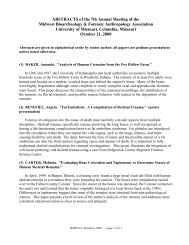Christopher W. Schmidt - University of Indianapolis Archeology ...
Christopher W. Schmidt - University of Indianapolis Archeology ...
Christopher W. Schmidt - University of Indianapolis Archeology ...
You also want an ePaper? Increase the reach of your titles
YUMPU automatically turns print PDFs into web optimized ePapers that Google loves.
1968; Finnegan and Marcsik, 1979; Hauser and DeStefano, 1989; Houghton, 1978; Ossenberg,<br />
1969; Rhine, 1990; Sawyer et al. 1979; Sawyer et al., 1998). Robusticity <strong>of</strong> muscle attachment<br />
sites is included to see if body build has an effect on the expression <strong>of</strong> mandibular traits. Two <strong>of</strong><br />
the traits examined (mylohyoid bridging and accessory mandibular foramen) are discrete<br />
(nominal) in nature and are scored either as “present” or “absent.” However, the other traits vary<br />
in a gradating order and must be scored in a different manner. These ordinal traits are described<br />
as “quasi-continuous” (Saunders, 1989) and have intermediate stages scored on a ranked scale.<br />
Ramus inversion. In some individuals, the edge <strong>of</strong> the posterior mandibular ramus is<br />
medially rotated (Angel and Kelley, 1990). Ramus inversion is an ordinal trait that is scored on<br />
a four-point scale (0 to 3) for the right and left sides <strong>of</strong> the mandible separately. A score <strong>of</strong> “0”<br />
indicates a completely straight ramus that lacks inversion. A score <strong>of</strong> “1” indicates slight<br />
inversion. A mandible that displays a moderate amount <strong>of</strong> incurvature <strong>of</strong> the ramus is given a<br />
score <strong>of</strong> “2.” A score <strong>of</strong> “3” indicates extreme inversion that dominates the majority <strong>of</strong> the<br />
ramus (Parr, 2003).<br />
Location <strong>of</strong> inversion. Both right and left rami are evaluated separately on a 3-point<br />
ordinal scale depending on the location <strong>of</strong> greatest incurvature. A score <strong>of</strong> “0” indicates that the<br />
greatest amount <strong>of</strong> incurvature is located in the lower third <strong>of</strong> the ramus. A mandible with<br />
inversion that is greatest in the middle third <strong>of</strong> the ramus is given a score <strong>of</strong> “1.” A score <strong>of</strong> “2”<br />
indicates a ramus with the greatest incurvature in the upper third <strong>of</strong> the ramus.<br />
Gonial eversion. Gonial angle eversion is scored separately on each side using a 5-point<br />
ordinal scale. A gonial angle displaying inversion is assigned a score <strong>of</strong> “–1.” A score <strong>of</strong> “0”<br />
indicates a gonion aligned with the ramus and completely lacking eversion or inversion (Rhine,<br />
1990). A mandible with slight eversion <strong>of</strong> the gonial angle is given a score <strong>of</strong> “1.” A score <strong>of</strong><br />
39








